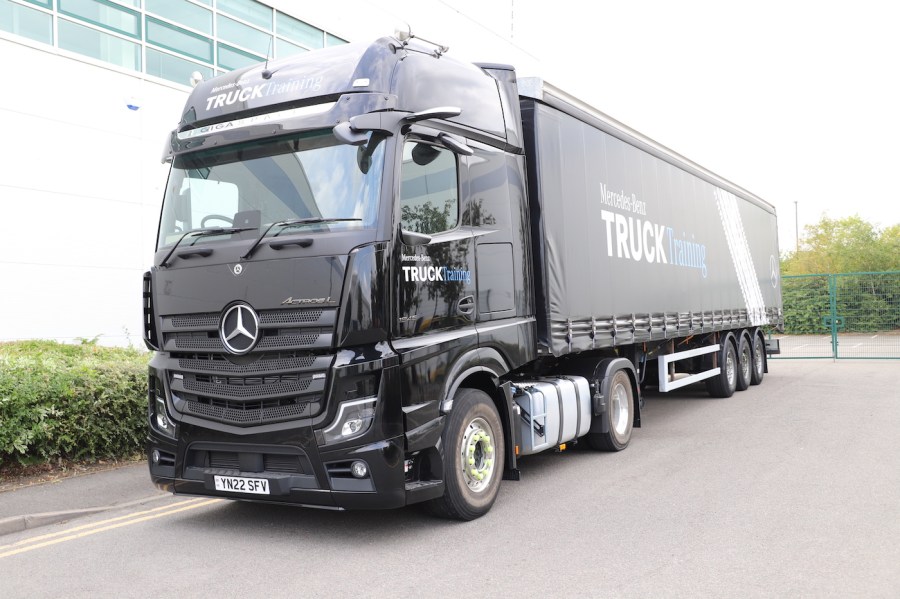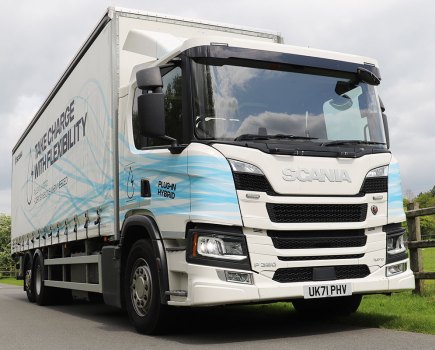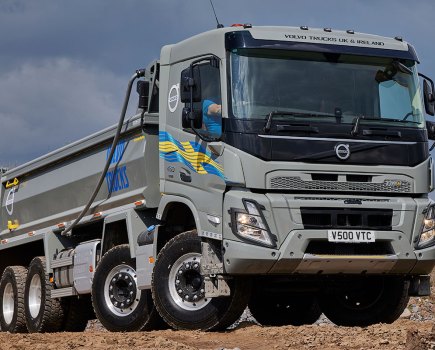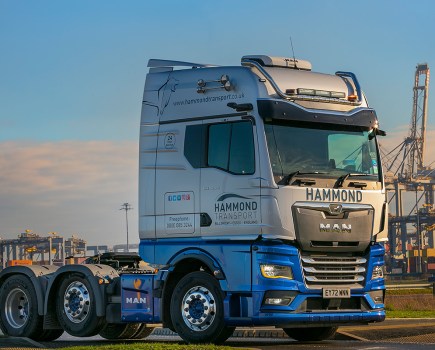Mercedes-Benz is continually updating its trucks, often with not too much fanfare. We took an Actros L 1845 out for a spin and found most of the safety features to be pretty good – but not all of them…
Mercedes introduced its Actros L last year, aimed at owner-drivers and small fleets where cab space is a premium. It benefits from a lower flat floor offering a marginal extra space of 4 cm (not a lot to shout about, admittedly), and also improved soundproofing – a real boon for overnighting drivers.
The Actros cab is now a decade old, but still one of the best on the market. It comes in many shapes and forms – two widths, numerous cab heights, day, rest and sleepers, so there really is something for every requirement.
The GigaSpace Actros is the biggest cab of the lot and much liked by long-haul drivers for its huge amount of internal space. It’s one of the few flat-floored cabs on the market, so requires a four-step entry to sit atop of the varied engine choices, including the biggest at 15.6-litre.
Technical overview
The Actros is now on its fifth incarnation and its second cab. The truck we’ve test driven this month was an 1845 GigaSpace, a spec that’s going to be more popular in Europe than in the UK as we still prefer 6x2s.
The truck had MirrorCam, but not the newest Version 2. However, in between driving the 1845 from Barnsley to Coventry and back, we also took an eActros 400 for a spin which did have MirrorCam 2 fitted, meaning we can offer an opinion on it (more on this later).
The 1845 has the 449 bhp OM471 engine, now on its second generation, but soon to be replaced by a new updated version. It’s a 12.8-litre straight-six delivering its power at 1600 rpm and a torque rating of 2200 Nm at 1100 rpm.
The truck had a five-stage engine brake which comes in automatically when the truck is going downhill with the cruise control set, so stops the truck running away – a very good feature.
The rear drive axle is rated at 13,000 kg and the front at 8000 kg – fairly standard for this kind of spec. It’s true that 4x2s remain in the minority for many UK users, and there’s a good reason for that – even if there are several applications where they are better suited. But for those UK operators solely doing continental work, they can make a lot of sense. The question is: if you are doing long-distance European work, would a 500 bhp engine be a better bet for journey savings and hill climbing?
On the road
The OM471 at 449 bhp is probably Merc’s most popular engine, but you can also have it at 421, 476, 510 and 530 bhp. We’ve always found the ‘45’ Mercs to be rather laboured and slightly lacklustre on hills. Fully loaded at 44 tonnes, they definitely struggle at times. But being an 1845, we were only legally allowed to run at 40 tonnes – and indeed that was the GVW on this test.
Indeed, this 1845 was certainly much better when it came to climbing the hills on the M1, and it was a bit of an eye-opener to see how just four tonnes less in GVW can have such a profound effect on its ability to motor.
The truck had Predictive Powertrain Control (PPC), which slows it down if the vehicle in front is slower, and then duly speeds you up again when you’ve passed it. As we get more used to drives with Merc’s system, it becomes more appealing. It can be flexible – you can set it to slow down sooner or later depending on your preference. The former, obviously, lends itself to safer driving, but soon gets frustrating; you can suddenly find yourself slowing down to 45 mph because of a slow driver in front of you.
If you set the gap too much to keep your speed up, you simply have to pull out to overtake that much earlier, which can infuriate other drivers. Setting it to the minimum level can help in that respect. But overall, PPC is a good safety feature and once you get the hang of it, its benefits probably far outweigh the negatives. Keep your eye on the road and react accordingly, it will help you out and save fuel.
A downside
Active Drive Assist, however, is infuriating. It’s not yet available on 6×2 midlifts, so few UK drivers probably have experience of it. The system ‘steers’ the truck to keep it within the white lines, but it’s just not an enjoyable experience. Understandably, you can’t take your hands off the wheel; but if you grip the wheel normally, you just feel it pulling and juddering all the time, which makes for an uncomfortable drive.
The technology relies on the white lines on the roads being clear enough for the system to read, and at times it loses track of them if they are broken or faded. We drove southbound with the system on, and northbound back to Barnsley with it switched off, and the return journey was far more enjoyable in that respect. We feel Active Drive Assist offers limited safety benefits and is uncomfortable to use. So it gets a thumbs down if you ask us; it’s not an optional extra we’d tick.
However, Merc has plenty of other safety gadgets on board, and Active Brake Assist (ABA, now on its fifth generation) is brilliant. This will stop the truck dead if it’s on a collision course in most circumstances where its physically possible to do so. For example, if a child runs out in front of the truck while you are travelling at 35 mph, then it’s more than likely you’ll not hit them. It’s ideal if you are on a motorway and there is stationary traffic ahead; it should stop you hitting the vehicle in front, although obviously you may get rear-ended if the vehicle behind doesn’t have ABA.
We think it’s a good feature and should really be a standard fit on all HGVs in this day and age. It will save lives, not to mention hefty repairs bills or write-offs.
Our test truck had the Hill Hold function, which is another brilliant piece of kit. With the system activated in stop-start traffic, or when you’re simply just held at traffic lights or a junction, pressing the brake pedal hard will essentially put the parking brake on. To pull away, you simply apply the gas. It’s very good, and very reliable.
The 1845 had Merc’s electronic parking brake which we’ve found unresponsive at times. But with Hill Hold, you actually don’t need to use it, apart from when you are actually parking the truck for any length of time.
Handling the truck (especially without ADA on) is fairly straightforward. The steering isn’t as light and enjoyable as a Volvo’s Dynamic Steering, for example, but it’s not bad at all. It can feel a bit laboured when pulling away, but we were fully loaded. The more we drive 450 bhp trucks at full weight around the UK, the more we are becoming drawn to 480, 500 or even 530 bhp lumps – the case for them gets stronger as the roads become more congested.
Although our 1845 was a training truck not kitted out as a tramper, we know the Merc standard cab interior is very well appointed. The GigaSpace is certainly one of the best and biggest top-of-the-range cabs, with bucket-loads of room and storage. The bed was once one of the best in the business, though Merc has lost ground compared to the new DAF XG – though in fairness, every manufacturer has been usurped by DAF’s wonderful new cab.
The Actros is not yet showing its age. Providing Merc stays ahead of the game, then it is going to appeal to drivers. The question is: will Merc be willing and able to exploit the new measurement legislation to provide a bigger cab – and will it want to?
Verdict
The 1845 (and its more common 2545 stablemate) is the quintessential gaffer’s motor. Maybe not with a GigaSpace cab, but certainly with a StreamSpace cab. Where it scores highly is its technological offerings for safety, and you should feel very comfortable and at ease when driving this truck. Just don’t let that make you complacent or lazy. For peace of mind, it’s reassuring to have ABA, PPC, Hill Hold and the like; and MirrorCam is superb.
We can’t make a case for ADA. It seems pointless, unnecessary and, if misused, potentially dangerous. But that said, we applaud Mercedes for continually moving the boundaries on safety and frequently being the first to bring such features to market.
The Actros L 1845 is certainly competent at 40 tonnes. At 44 tonnes, we’d always suggest a 2548 or 2551 as a better bet. The 1845 is a good all-rounder; it’s a competent machine and we like a lot of its safety features very much indeed.
We like
+ Active Brake Assist
+ MirrorCam
+ Hill Hold
+ Predictive Powertrain Control
+ Great forward visibility
We don’t like
– Active Arive Assist
– Getting in via four staps!






